#formation in Myanmar
Explore tagged Tumblr posts
Text
Company formation in Myanmar is governed by the Myanmar Companies

Company formation in Myanmar is governed by the Myanmar Companies Law 2017, overseen by the Directorate of Investment and Company Administration (DICA). Foreign investors can establish a Private Limited Company (Ltd), which allows up to 100% foreign ownership in most sectors, with some restrictions in specific industries.
Key steps include reserving a company name through DICA’s MyCO online system, preparing the company’s constitution (or Articles of Association), and submitting incorporation documents. Once approved, DICA issues a Certificate of Incorporation along with a Company Registration Number.
After registration, the company must obtain a Taxpayer Identification Number (TIN) from the Internal Revenue Department and register for Commercial Tax (if applicable). A local bank account is also required. Depending on the business activities, additional sector-specific permits or licenses may be necessary. For compliance, companies must register employees with the Social Security Board (SSB) and adhere to Myanmar’s labor laws regarding contracts, working conditions, and benefits.
0 notes
Text
this letter signed by several of the luminaries of the modern left in the west actually manages to undercut any point it wants to make immediately lol.
Israel/Palestine has become the central morality drama for much of the contemporary left, in a way that South Africa was for many in a previous generation. [...]
At the same time, both mainstream and leftist media outlets pay vastly more attention to Palestine/Israel than to Syria, Kurdistan, Sudan, Ethiopia, the DRC, Sri Lanka, Myanmar or any number of other global flashpoints in which militarist states (or non-state actors) oppress national and ethnic minorities, or carry out massacres.
omg why don't you care about other things instead of this conflict where all of the western world is offering multi billion dollar aid packages to an occupying rogue state that murders un workers and children? you should actually not be galvanized by the unique ways in which solidarity with palestinians and participating in bds can lose you your job and is criminalised? ofc israel palestine its central to the western left
gaza's bombardment is urgent, violent, immediately palpable due to the years of work palestinian journos and activists have put in this awful whataboutism is genuinely such an ugly urge.
Much of the left has turned potentially useful concepts like “settler-colonialism” from tools of analysis into substitutes for analysis. Applying these labels in a simplistic way allows activists to avoid a confrontation with complexity. The historical internal diversity of Zionism, its ambivalent relationship with various imperialisms, and the different stories of displacements that drove Jewish migration to Israel from various countries are often little understood.
The process of Israeli Jewish national formation included settler colonisation that saw large numbers of existing inhabitants displaced, including via war crimes and expulsions. It was also a process of a desperate flight by people who had themselves been victims of racist violence and attempted extermination. The Palestinians are, in Edward Said’s phrase, “the victims of the victims and the refugees of the refugees.” Israeli Jews are far from unique in having consolidated themselves as a nation, and founded a state, on a basis that included violent dispossession of a territory’s existing inhabitants.
is this diverse zionism in the room with us right now?
Jews everywhere – who are often tied in multiple ways to people and places in Israel – feel under attack when Israelis in general are targeted.
lol. this is antisemitic dual loyalty bullshit.
38 notes
·
View notes
Text



Lustrous Topaz crystal with gem clarity and well formed termination, Mogok near Momiek (Myanmar). Large at 73.3 grams.
Offering a really great gem Topaz crystal. Extreme luster, well formed sharp edges and great clarity makes this one a desirable gem crystal. 73.3 grams. Champagne color and so fine. No damage. Mined in the 80's Mogok near Momiek. (Burma). Reasonable price considering size, sharp formation and condition.
https://goldenhourminerals.etsy.com/listing/1530351394
25 notes
·
View notes
Text
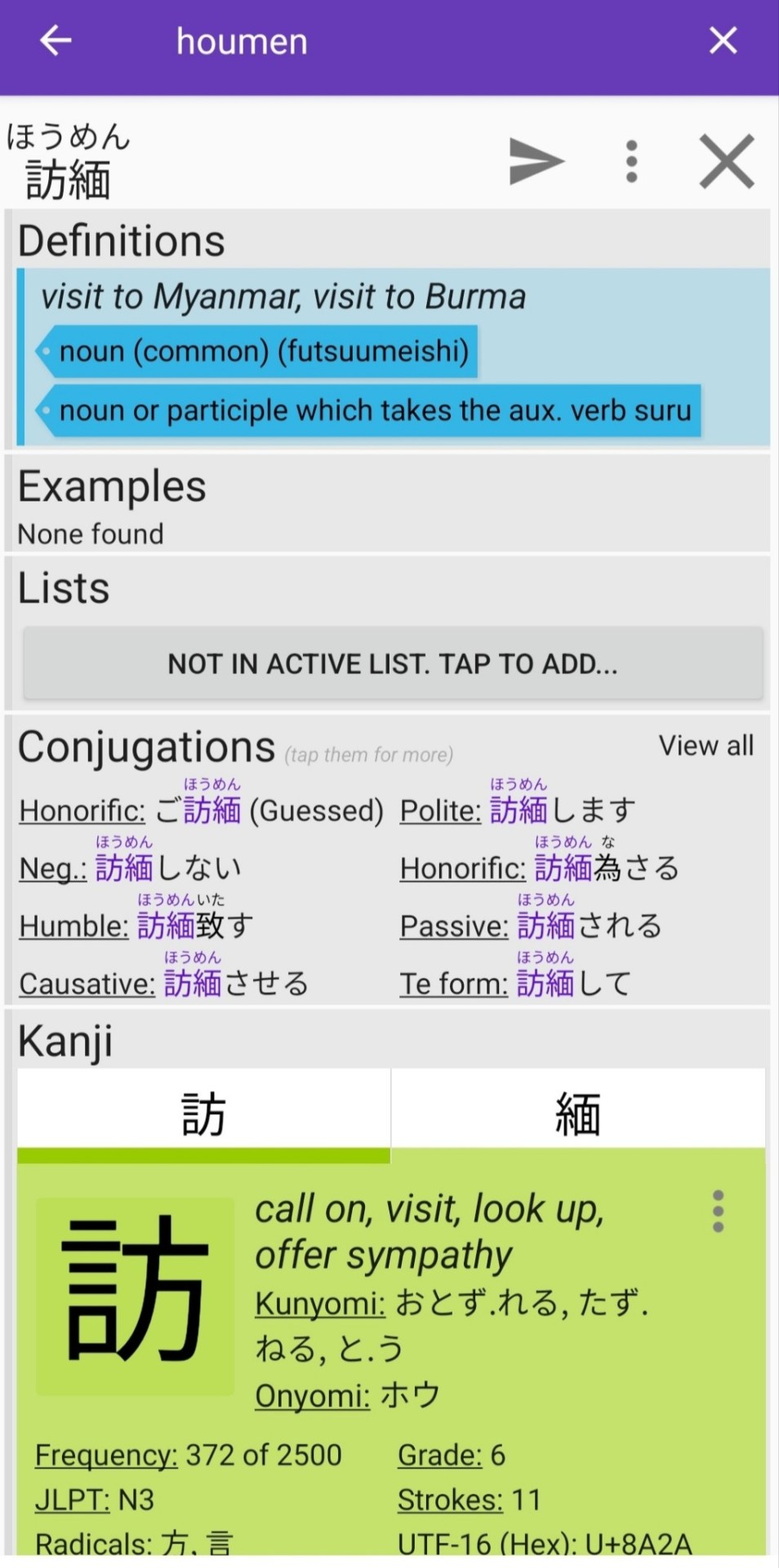
Now, that's a specific word. Why is this word used so many times that it would end up in Akebi dictionary? Also, yeah, I know that's kanji for Myanmar but Japanese people don't really use it anymore. They use ミャンマー instead.
So I looked it up and there are other words like "visit to korea" "visit to japan" etc. all with this 訪+country format but I'm just surprised that there's one for Myanmar. Probably a word leftover from the time when Japanese used to occupy Myanmar.
27 notes
·
View notes
Note
can you guys chill lmao. just trying to help
Sapphire is a precious gemstone, a variety of the mineral corundum, consisting of aluminium oxide (α-Al2O3) with trace amounts of elements such as iron, titanium, cobalt, lead, chromium, vanadium, magnesium, boron, and silicon. The name sapphire is derived from the Latin word sapphirus, itself from the Greek word sappheiros (σάπφειρος), which referred to lapis lazuli. It is typically blue, but natural "fancy" sapphires also occur in yellow, purple, orange, and green colors; "parti sapphires" show two or more colors. Red corundum stones also occur, but are called rubies rather than sapphires. Pink-colored corundum may be classified either as ruby or sapphire depending on locale. Commonly, natural sapphires are cut and polished into gemstones and worn in jewelry. They also may be created synthetically in laboratories for industrial or decorative purposes in large crystal boules. Because of the remarkable hardness of sapphires – 9 on the Mohs scale (the third hardest mineral, after diamond at 10 and moissanite at 9.5) – sapphires are also used in some non-ornamental applications, such as infrared optical components, high-durability windows, wristwatch crystals and movement bearings, and very thin electronic wafers, which are used as the insulating substrates of special-purpose solid-state electronics such as integrated circuits and GaN-based blue LEDs. Sapphire is the birthstone for September and the gem of the 45th anniversary. A sapphire jubilee occurs after 65 years.
Sapphire is one of the two gem-varieties of corundum, the other being ruby (defined as corundum in a shade of red). Although blue is the best-known sapphire color, they occur in other colors, including gray and black, and also can be colorless. A pinkish orange variety of sapphire is called padparadscha.
Significant sapphire deposits are found in Australia, Afghanistan, Cambodia, Cameroon, China (Shandong), Colombia, Ethiopia, India Jammu and Kashmir (Padder, Kishtwar), Kenya, Laos, Madagascar, Malawi, Mozambique, Myanmar (Burma), Nigeria, Rwanda, Sri Lanka, Tanzania, Thailand, United States (Montana) and Vietnam. Sapphire and rubies are often found in the same geographical settings, but they generally have different geological formations. For example, both ruby and sapphire are found in Myanmar's Mogok Stone Tract, but the rubies form in marble, while the sapphire forms in granitic pegmatites or corundum syenites.
Every sapphire mine produces a wide range of quality, and origin is not a guarantee of quality. For sapphire, Jammu and Kashmir receives the highest premium, although Burma, Sri Lanka, and Madagascar also produce large quantities of fine quality gems.
The cost of natural sapphires varies depending on their color, clarity, size, cut, and overall quality. Sapphires that are completely untreated are worth far more than those that have been treated. Geographical origin also has a major impact on price. For most gems of one carat or more, an independent report from a respected laboratory such as GIA, Lotus Gemology, or SSEF, is often required by buyers before they will make a purchase.
9 notes
·
View notes
Text
Myanmar 2021 - Protesters pratice shield formations before clashes with the police
21 notes
·
View notes
Text
The History and Significance of Burmese Rubies
Rubies have long captivated humanity with their fiery red brilliance and storied past. Among these, Burmese rubies stand out, renowned for their exceptional quality and deep, vibrant color. At [Rewa Jewelry](https://rewa.jewelry/), we take pride in offering some of the finest Burmese rubies, each gemstone a testament to the rich history and cultural significance that these gems carry.
Origins of Burmese Rubies
Burmese rubies originate from the Mogok Valley in Myanmar, a region often referred to as the "Valley of Rubies." This area has been the world's primary source of rubies for centuries. The geological conditions in Mogok are unique, allowing the formation of rubies with a pigeon blood-red hue, the most coveted shade for these gemstones.
The history of Burmese ruby mining dates back over a thousand years. Ancient Burmese texts reference these precious stones, and they have been part of local lore and legend. The Mogok Valley's mines were initially worked by hand, and despite modern advances, much of the ruby extraction in this region is still performed using traditional methods, preserving the historical practices.
Legendary Status and Cultural Significance
Burmese rubies have always been more than just beautiful stones; they hold significant cultural and mystical importance. Throughout history, they have been symbols of wealth, power, and protection. In Burmese culture, these gems were believed to possess protective properties, warding off evil and bringing good fortune to their owners.
Royal Connections
Throughout history, Burmese rubies have adorned the crowns and regalia of royalty. Kings and queens across Asia and Europe coveted these gemstones for their unrivaled beauty and purported protective qualities. The famed British Crown Jewels, for example, include several notable Burmese rubies, reflecting their historical value and significance.
Mystical Properties
Beyond their physical beauty, Burmese rubies have been ascribed various mystical properties. In ancient times, warriors would embed rubies into their skin, believing the stones would make them invincible in battle. Moreover, these rubies were thought to bring peace and prosperity, protect against illnesses, and even improve the wearer's leadership abilities.
Burmese Rubies in Modern Times
Today, Burmese rubies continue to be highly prized by gem enthusiasts and collectors worldwide. Their rarity and unmatched color make them a worthy investment and a treasured heirloom. At [Rewa Jewelry](https://rewa.jewelry/), we are committed to sourcing these gems ethically, ensuring that each ruby not only meets the highest standards of quality but also contributes positively to the communities involved in their mining and trade.
Ethical Sourcing
The journey of a Burmese ruby from the Mogok Valley to your jewelry collection is one we take very seriously. We prioritize ethical sourcing practices, ensuring that our gemstones are mined responsibly and that the local communities benefit from this trade. This commitment to ethical practices ensures that when you purchase a ruby from [Rewa Jewelry](https://rewa.jewelry/), you are supporting sustainable and fair-trade practices.
Conclusion
Burmese rubies are more than just gemstones; they are pieces of history, symbols of cultural significance, and testaments to the beauty and resilience of nature. Whether you are a collector, a lover of fine jewelry, or someone looking to make a meaningful purchase, a Burmese ruby is an investment in both beauty and heritage.
Explore our exquisite collection of Burmese rubies at [Rewa Jewelry](https://rewa.jewelry/) and find a piece that speaks to you. Each ruby carries with it a legacy of luxury, history, and unparalleled beauty, ready to become a cherished part of your story.

Rewa Jewelry Official Website
Discover the world’s rarest rubies. Motivated by exploring all realms of design, driven by celebrating timeless heritage. Since 2008.
2 notes
·
View notes
Text
Events 5.11
330 – Constantine the Great dedicates the much-expanded and rebuilt city of Byzantium, changing its name to New Rome and declaring it the new capital of the Eastern Roman Empire. 868 – A copy of the Diamond Sūtra is published, making it the earliest dated and printed book known. 973 – In the first coronation ceremony ever held for an English monarch, Edgar the Peaceful is crowned King of England, having ruled since 959 AD. His wife, Ælfthryth, is crowned queen, the first recorded coronation for a Queen of England. 1068 – Matilda of Flanders, wife of William the Conqueror, is crowned Queen of England. 1258 – Louis IX of France and James I of Aragon sign the Treaty of Corbeil, renouncing claims of feudal overlordship in one another's territories and separating the House of Barcelona from the politics of France. 1713 – Great Northern War: After losing the Battle of Helsinki to the Russians, the Swedish and Finnish troops burn the entire city, so that it would not remain intact in the hands of the Russians. 1812 – Prime Minister Spencer Perceval is assassinated by John Bellingham in the lobby of the British House of Commons. 1813 – William Lawson, Gregory Blaxland and William Wentworth discover a route across the Blue Mountains, opening up inland Australia to settlement. 1857 – Indian Rebellion of 1857: Indian rebels seize Delhi from the British. 1880 – Seven people are killed in the Mussel Slough Tragedy, a gun battle in California. 1889 – An attack upon a U.S. Army paymaster and escort results in the theft of over $28,000 and the award of two Medals of Honor. 1894 – Four thousand Pullman Palace Car Company workers go on a wildcat strike. 1919 – Uruguay becomes a signatory to the Buenos Aires copyright treaty. 1970 – The 1970 Lubbock tornado kills 26 and causes $250 million in damage. 1985 – Fifty-six spectators die and more than 200 are injured in the Bradford City stadium fire. 1996 – After the aircraft's departure from Miami, a fire started by improperly handled chemical oxygen generators in the cargo hold of Atlanta-bound ValuJet Airlines Flight 592 causes the Douglas DC-9 to crash in the Florida Everglades, killing all 110 on board. 1997 – Deep Blue, a chess-playing supercomputer, defeats Garry Kasparov in the last game of the rematch, becoming the first computer to beat a world-champion chess player in a classic match format. 1998 – India conducts three underground atomic tests in Pokhran. 2011 – An earthquake of magnitude 5.1 hits Lorca, Spain. 2013 – Fifty-two people are killed in a bombing in Reyhanlı, Turkey. 2014 – Fifteen people are killed and 46 injured in Kinshasa, DRC, in a stampede caused by tear gas being thrown into soccer stands by police officers. 2016 – One hundred and ten people are killed in an ISIL bombing in Baghdad. 2022 – The Burmese military executes at least 37 villagers during the Mon Taing Pin massacre in Sagaing, Myanmar. 2024 - Minnesota officially updates its flag.
2 notes
·
View notes
Text
First and foremost, NATO must continue to defend its existing members successfully. However, To do that effectively requires repositioning to deal with threats that NATO’s founders never imagined. In addition to the Russian menace to European states like Ukraine, Moldova, and Georgia, NATO faces wider global concerns. From digital and economic hybrid warfare tactics to climate crises and terrorism, the dangers to NATO member states are increasingly borderless and not limited to kinetic threats from nation-states. While far from fully established, the “no limits” alliance of China and Russia declared by Xi Jinping is already underway and presents a serious risk.
To successfully defend the existing alliance against this proliferation of hybrid threats, NATO must open its doors to new members beyond Europe and North America(..)
A globally open NATO is additionally crucial because there is no viable alternative able to deter aggression. Since the end of the Cold War, the United Nations (UN), the only multilateral institution with a global peacekeeping mandate, has spectacularly failed to prevent or stop genocide in Rwanda, the Balkans, Darfur, Myanmar, and now Ukraine.
P.S. Interesting thought! However, it should be added that NATO is only as effective as the political and public opinion of the countries that are part of this organization is effective. Unfortunately, the events in Ukraine, the Trump phenomenon in the USA, the growing phenomenon of right-wing and left-wing populism, and the unhindered infiltration of Islamists in other developed Western countries show that the "old" West can no longer really be relied on in security matters. For such Asian countries as South Korea, Japan, Taiwan, etc. it is better to build your own collective security organization and develop your own military industry...
Forget about the UN altogether. It is as useless an organization as the League of Nations before World War II.
This useless formation is only good for talking! It will not protect you from Russia, Chinese Communists or Islamist invasion. If democracies want to protect their security, you have only one guarantor: your own armed forces and reliable allies...
#NATO#defense of liberty#defense of freedom#indigenous military industry#russian threats#Ukraine#Jessica Berlin
7 notes
·
View notes
Text

Blue Helmet Bureaucrats
مراجعة كتاب (بيروقراطيو/نمطيو الخوذ الزرق أبريل2023: عمليات الأمم المتحدة لحفظ السلام وإعادة اختراع الاستعمار، 1945-1971). ثبت أن الأمم المتحدة كانت تعبيرا عن المصالح الاستعمارية والحرب الباردة للدول القومية في هذه الفترة. -عدد مايو 2024 https://academic.oup.com/ia/article-abstract/100/3/1312/7663893
Blue helmet bureaucrats: United Nations peacekeeping and the reinvention of colonialism, 1945–1971
Blue Helmet Bureaucrats: United Nations Peacekeeping and the Reinvention of Colonialism, 1945–1971 by Margot Tudor | Goodreads
Blue helmet bureaucrats: United Nations peacekeeping and the reinvention of colonialism, 1945–1971
By MargotTudor. Cambridge University Press. April, 2023. 310 pp.
£85.00.
ISBN978 1 00926 492 1. Available as e-book.
Review: Hamish McDougall
International Affairs, Volume 100, Issue 3, May 2024, Pages 1312–1313, https://doi.org/10.1093/ia/iiae117
Published: 07 May 2024
The ongoing violence in Gaza, Myanmar, Ukraine and Yemen is a confronting reminder, if one was ever needed, of the ineffectiveness of the United Nations and other elements of the international system to keep peace. Anyone pondering how and why we got here would benefit from reading Margot Tudor's new book, which provides a history of UN peacekeeping efforts via a series of case-studies from the second half of the twentieth century. It is now reasonably well established that the UN was an expression of the colonial and Cold War interests of nation-states in this period. Conversely, it was also a vehicle to advance the interests of the recently decolonized or ‘non-aligned’ states of the global South (frequently termed ‘the Afro-Asian bloc’ in this book). Less well known, and providing a large part of this book's value, is that the UN was not just a tabula rasa for nation-states, but it was also an actor in its own right. In other words, the UN created, executed and perpetuated particular norms, cultures and actions around the world.
Summary
The end of the ’spirit of Bandung’ in the late 1960s coincided with the passing and retirement of most of the key UN officials involved in the development of the peacekeeping project. By 1971, the Cold War obstructed the UN forums from authorising any new armed peacekeeping missions. Weaving together the contributions of previous chapters, the conclusion reiterates the how UN peacekeepers’ racial prejudices and technocratic logic perpetuated international hierarchies of power, colonial structures, and further suppressed the self-determination of peripheral or minority populations. It addresses the role of the UN peacekeeping missions in supporting - if not, openly enabling - the United States’ anticommunist aggression across the Global South during the decolonisation period. Rather than being passive in this process, however, this book has demonstrated how the UN officials agreed that anticommunism was a peacebuilding strategy for global security. Ultimately, peacekeepers’ unique role in the field shaped the formation of the post-colonial international order, embedding uneven hierarchies of race, expertise, and diplomatic power within newly independent nations and populations.
Blue Helmet Bureaucrats (cambridge.org)
#book review#book quotes#books#goodreads#book covers#un#imperialism#afro asian#suez canal#gaza#rafah#united nations#ryan guzman#taylor swift#eurovision#anti zionisim#CNN#news#breaking news#us news source#NPR#Eurovision 2024#BoycottPureGym#investigation#FridayFeeling#prince harry#Invictus Games
1 note
·
View note
Text
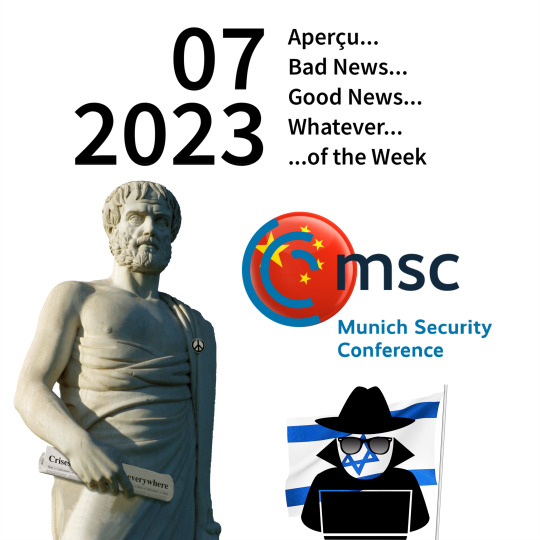
2023 / 07
Aperçu of the Week:
"Success has two letters: Do!"
(Johann Wolfgang von Goethe)
Bad News of the Week:
The only serious competition to Silicon Valley is neither in Europe nor in the Far East, but between the Dead, the Red and the Mediterranean Sea: Israel. Unfortunately. Because it's rather frightening innovations that come out of the more than 300 development and research centers around Tel Aviv. And I don't mean the energy that the state puts into cutting-edge technology for the military, surveillance and espionage. But rather the focus that private-sector companies in the region have also chosen.
Three examples: Cellebrite openly advertises that it can crack iDevices. Much to the delight of the FBI, for example, because Apple had refused to crack iPhones for U.S. authorities or to build a backdoor into their encryption. The questionable services are open to any organization, even criminal ones, for a fee, as if it were a normal IT service.
NSO became a global player in commercial spyware. A market that has grown into an industry estimated to be worth twelve billion dollars, estimates The New Yorker. Their tool named Pegasus was found on the phones of politicians, activists, and dissidents under repressive regimes. The suppression of the Catalan independence movement and the murder of Saudi Arabian journalist Jamal Khashoggi with the help of this spyware are documented.
And just last week, investigative media revealed Team Jorge's business model: professional spreading of fake news to influence elections. They were hired for 32 campaigns, 27 of which were verifiably successful, they say. Yes, political success can be bought - at the expense of the opposition.
What these three examples have in common is a perfidious "not giving a fuck" attitude, which goals are pursued and also achieved with their help. For these are clearly directed against such trivialities as free democracy, independent media, functional rule of law or transparent power apparatuses. The main thing is that the money is right. The framework conditions for this seem to be optimal in Israel, of all places. And when I look at the position of Benjamin Netanyahu's newly enthroned right-wing government against an independent judiciary or free media, this will not change.
Good News of the Week:
In mid-February, Munich always hosts the "Munich Security Conference" (MSC), the world's most important meeting of top politicians on international security. While last year appeals to Russia not to attack Ukraine dominated - we all know what happened a few days later - this time it is about the concrete handling of the war that initiated the much-cited "turning point in time":
The unexpectedly dysfunctional NATO is strengthening internally (higher defense budgets) and externally (Sweden and Finland want to join the alliance), new bloc formations are emerging, the arms industry can no longer keep up with demand, Europe is groaning under a wave of refugees, economic sanctions by the West are turning out to be far less effective than expected, Putin is not wavering. War has become the order of the day.
Major strategic news is not to be expected. All countries have already clearly positioned themselves. From clear, even military support for Ukraine (e.g. all NATO members) to an effort of neutrality based on energy policy (e.g. India or Latin America) to support for the Putin course (e.g. Belarus, Syria or Myanmar). All countries have already taken a clear position? No - the elephant in the room is China.
The youngest major security power calls for peace, but does not name Russia as the aggressor. And just yesterday launched "Operation Mosi II," a joint large-scale naval maneuver with Russia and South Africa off the latter's Indian Ocean coast. So there was little hope that the Middle Kingdom - seen by almost all observers as the only power with de facto influence over the Kremlin - would actively do anything to defuse the conflict.
But then Wang Yi, longtime foreign minister of the People's Republic of China, entered the Munich stage - and stunned. By announcing a peace initiative to end Russia's war of aggression against Ukraine, he said, "We will put something forward. And that is the Chinese position on the political settlement of the Ukraine crisis," the Politburo member said Saturday, according to an official translation. "We will stand steadfastly on the side of peace and dialogue." For a safer world, he said, "the principles of the UN Charter are something we must uphold." Good. Very good. Now words just need to be followed by action.
Personal happy moment of the week:
In our countryside, there are plenty of typical Bavarian inns. And, as everywhere, countless Italians and Asians. Rarer are nice cafés where you can have a good breakfast. One we have - thanks to a voucher that I already got last year for my birthday - tried today. Very good coffee, a manageable but balanced menu. With regional products and in a former monastery building. It was worth it. It's always nice to start the Sunday with a delicious breakfast.
I couldn't care less...
...that Ukraine has requested cluster bombs and chemical weapons on the MSC. These are internationally outlawed because they cause massive collateral damage in violation of international law - including to the civilian population. That Russia is not caring about this may be, is even probable. Nevertheless, this quid pro quo logic is too weak for me. If they go low, you (still should) go high.
As I write this...
...I am mourning a little Lothar Wieler quitting his job. As head of the Robert Koch Institute (RKI) he was the Anthony Fauci of Germany. And yet more than just the side kick of the respective health minister. As a politically independent person, he moderated the pandemic in a serious but calm manner. He analyzed, commented, admonished and annoyed. Far away from the day-to-day political business. Against his will, he became a media star, even though he much preferred to sit in the lab and work on his figures. He did what he thought he had to do. Tormented by the thought that "even one more child must die". Big shoes to fill.
Post Scriptum
To be climate neutral, each person should only emit less than one ton of CO2 or similar greenhouse gases per year - currently the average is 11.6 tons. Far ahead of the consumption of beef or air travel to the South, individual transport is the main polluter: the Germans' favorite child, the car. But the will in this country to rely on electromobility seems to be driven more by financial interests than by actual conviction. When gasoline was expensive and electric cars were tax-subsidized in 2022, there was a boom. That plummeted dramatically over the turn of the year, with 83 percent fewer fully electric cars and 87 percent fewer plug-in hybrids registered in January 2023 compared to the previous month. Sigh...
#thoughts#aperçu#good news#bad news#news of the week#happy moments#politics#johann wolfgang von goethe#success#israel#silicon valley#tel aviv#spyware#fake news#cracking#munich#munich security conference#china#Wang Yi#breakfast#sunday#ukraine#weapons#pandemic#climate#neutral#electric cars#russia#quid pro quo#un charter
3 notes
·
View notes
Text
History Of Devanagari Script

Devanagari is a combination of the word’s deva and nagari. Deva translates as “heavenly,” “divine,” or “deity.” Nagari derives from Nagaram, a Sanskrit word that means “town.” Devanagari can therefore be rendered as “from the home of divinity.” The ancient term Nagar gave rise to the name Devanagari.
Nagari was one of the primary scripts used for the Sanskrit literature and first appeared in the northwest of the Indian subcontinent around 633 CE. It was fully evolved by the 11th century CE.
The 1st to 4th century CE inscriptions found in Gujarat provide some of the earliest epigraphic evidence of the development of the Sanskrit Nagar script in ancient India. [10] Nagar script variants, which are recognisable as being close to Devanagari, are first documented in Sanskrit Rudradaman inscriptions from the first century CE,Inscriptions from the Middle Ages indicate widespread use of scripts related to the Nagari, with scripts exhibiting local script alongside the adoption of Nagari scripts. For instance, the Siddha Matrika script and an early Telugu-Kannada script can both be found on the Pattadakal pillar from the middle of the eighth century in Karnataka.
By the seventh century CE, the Nagari script was in widespread use, and by the end of the first millennium, it had reached its full development. Numerous pillar and cave-temple inscriptions, like the 11th-century Udayagiri inscriptions in Madhya Pradesh, attest to the employment of Sanskrit in Nagari script in mediaeval India.
Moreover, the British Museum is home to an inscribed brick from 1217 CE that was discovered in Uttar Pradesh. Prototypes of the script and related variations have been found alongside historic artefacts outside of India, in places including Sri Lanka, Myanmar, and Indonesia. Buddhists in East Asia used the Siddha Matrika script, which is thought to be the closest ancestor of Nagari has historically been the foremost among the Indian scripts.
It has been used by religiously educated people in South Asia for a very long time to record and convey information, coexisting alongside a wide range of regional scripts (such as Mo, Kaithi, and Mahajani) used for administration, trade, and other daily activities all throughout the country.
In Kashmir, Sharada is still used in parallel. The Kutila inscription of Bareilly, which dates to VS 1049 (992 CE), exhibits the formation of the horizontal bar to combine letters pertaining to a word in an early form of Devanagari. [1] With a writing date of roughly 150 BCE and a transcription date of the 14th century CE, the 1,413 Nagari pages of a commentary by Patanjali are one of the earliest Sanskrit manuscripts from the early post-Maurya period still in existence.
Penkraft conducts classes, course, online courses, live courses, workshops, teachers’ training & online teachers’ training in Handwriting Improvement, Calligraphy, Abacus Maths, Vedic Maths, Phonics and various Craft & Artforms – Madhubani, Mandala, Warli, Gond, Lippan Art, Kalighat, Kalamkari, Pichwai, Cheriyal, Kerala Mural, Pattachitra, Tanjore Painting, One Stroke Painting, Decoupage, Image Transfer, Resin Art, Fluid Art, Alcohol Ink Art, Pop Art, Knife Painting, Scandinavian Art, Water Colors, Coffee Painting, Pencil Shading, Resin Art Advanced etc. at pan-India locations. With our mission to inspire, educate, empower & uplift people through our endeavours, we have trained & operationally supported (and continue to support) 1500+ home-makers to become Penkraft Certified Teachers? in various disciplines.
2 notes
·
View notes
Text
Here are the pdf versions of solidarity Verso Books (for ease of accessibility):
Ten Myths About Israel by Ilan Pappe.
In this groundbreaking book, published on the fiftieth anniversary of the Occupation, the outspoken and radical Israeli historian Ilan Pappe examines the most contested ideas concerning the origins and identity of the contemporary state of Israel.
The “ten myths” that Pappe explores—repeated endlessly in the media, enforced by the military, accepted without question by the world’s governments—reinforce the regional status quo. He explores the claim that Palestine was an empty land at the time of the Balfour Declaration, as well as the formation of Zionism and its role in the early decades of nation building. He asks whether the Palestinians voluntarily left their homeland in 1948, and whether June 1967 was a war of “no choice.” Turning to the myths surrounding the failures of the Camp David Accords and the official reasons for the attacks on Gaza, Pappe explains why the two-state solution is no longer viable.
The Palestine Laboratory by Antony Loewenstein.
Israel's military industrial complex uses the occupied, Palestinian territories as a testing ground for weaponry and surveillance technology that they then export around the world to despots and democracies. For more than 50 years, occupation of the West Bank and Gaza has given the Israeli state invaluable experience in controlling an "enemy" population, the Palestinians. It's here that they have perfected the architecture of control.
Best-selling journalist Antony Loewenstein, author of Disaster Capitalism, uncovers this largely hidden world in a global investigation with secret documents, revealing interviews and on-the-ground reporting. This book shows in-depth, for the first time, how Palestine has become the perfect laboratory for the Israeli military-techno complex: surveillance, home demolitions, indefinite incarceration and brutality to the hi-tech tools that drive the 'Start-up Nation'. From the Pegasus software that hacked Jeff Bezos' and Jamal Khashoggi's phones, the weapons sold to the Myanmar army that has murdered thousands of Rohingyas and drones used by the European Union to monitor refugees in the Mediterranean who are left to drown. Israel has become a global leader in spying technology and defence hardware that fuels the globe's most brutal conflicts. As ethno-nationalism grows in the 21st century, Israel has built the ultimate model.
Palestine Speaks Edited by Mateo Hoke and Cate Malek.
For more than six decades, Israel and Palestine have been the center of one of the world’s most widely reported yet least understood human rights crises. In Palestine Speaks men and women from the West Bank and Gaza describe in their own words how their lives have been shaped by the conflict. This includes eyewitness accounts of the most recent attacks on Gaza in 2014.
The collection includes Ebtihaj, whose son, born during the first intifada, was killed by Israeli soldiers during a night raid almost twenty years later. Nader, a professional marathon runner from the Gaza Strip who is determined to pursue his dream of competing in international races despite countless challenges, including severe travel restrictions and a lack of resources to help him train.
Blaming the Victims, (mention after summary)
Since the 1948 war which drove them from their heartland, the Palestinian people have consistently been denied the most basic democratic rights. Blaming the Victims shows how the historical fate of the Palestinians has been justified by spurious academic attempts to dismiss their claim to a home within the boundaries of historical Palestine and even to deny their very existence.
Beginning with a thorough exposé of the fraudulent assertions of Joan Peters concerning the indigenous inhabitants of Palestine prior to 1948, the book then turns to similar instances in Middle East research where the truth about the Palestinians has been systematically suppressed: from the bogus—though still widely believed—explanations of why so many Palestinians fled their homes in 1948, to today’s distorted propaganda about PLO terrorism. The volume also includes sharp critiques of the wide consensus in the USA which supports Israel and its territorial ambitions while maintaining total silence about the competing reality of the Palestinians.
(Contributions by Ibrahim Abu-Lughod, Janet L. Abu-Lughod, G.W. Bowersock, Noam Chomsky, Norman G. Finkelstein, Muhammad Hallaj, Rashid Khalidi, Peretz Kidron and Elia Zureik
Edited by Christopher Hitchens and Edward W. Said)
The Punishment of Gaza by Gideon Levy.
Israel’s 2009 invasion of Gaza was an act of aggression that killed over a thousand Palestinians and devastated the infrastructure of an already impoverished enclave. The Punishment of Gaza shows how the ground was prepared for the assault and documents its continuing effects.
From 2005—the year of Gaza’s “liberation”—through to 2009, Levy tracks the development of Israel policy, which has abandoned the pretense of diplomacy in favor of raw military power, the ultimate aim of which is to deny Palestinians any chance of forming their own independent state. Punished by Israel and the Quartet of international powers for the democratic election of Hamas, Gaza has been transformed into the world’s largest open-air prison. From Gazan families struggling to cope with the random violence of Israel’s blockade and its “targeted” assassinations, to the machinations of legal experts and the continued connivance of the international community, every aspect of this ongoing tragedy is eloquently recorded and forensically analyzed. Levy’s powerful journalism shows how the brutality at the heart of Israel’s occupation of Palestine has found its most complete expression to date in the collective punishment of Gaza’s residents.
The Case for Sanctions Against Israel, (Mention after summary)
In July 2011, Israel passed legislation outlawing the public support of boycott activities against the state, corporations, and settlements, adding a crackdown on free speech to its continuing blockade of Gaza and the expansion of illegal settlements. Nonetheless, the campaign for boycott, divestment, and sanctions (BDS) continues to grow in strength within Israel and Palestine, as well as in Europe and the US.
This essential intervention considers all sides of the movement—including detailed comparisons with the South African experience—and contains contributions from both sides of the separation wall, along with a stellar list of international commentators.
(Contributions by Ra'anan Alexandrowicz, Merav Amir, Hind Awwad, Mustafa Barghouthi, Omar Barghouti, Dalit Baum, Joel Beinin, John Berger, Angela Davis, Nada Elia, Marc H. Ellis, Noura Erakat, Neve Gordon, Ran Greenstein, Ronald Kasrils, Jamal Khader, Naomi Klein, Paul Laverty, Mark LeVine, David Lloyd, Ken Loach, Haneen Maikey, Rebecca O'Brien, Ilan Pappe, Jonathan Pollak, Laura Pulido, Lisa Taraki, Rebecca Vilkomerson, Michael Warschawski and Slavoj Žižek
Edited by Audrea Lim)
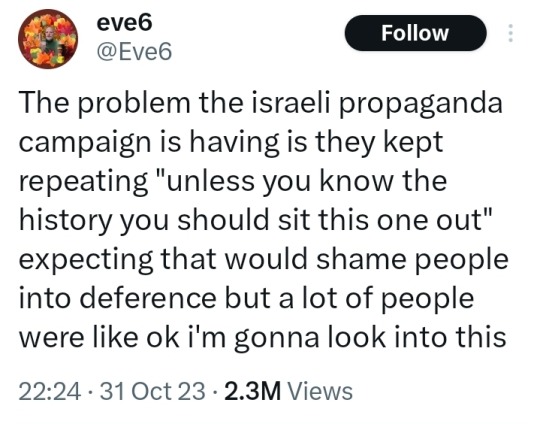
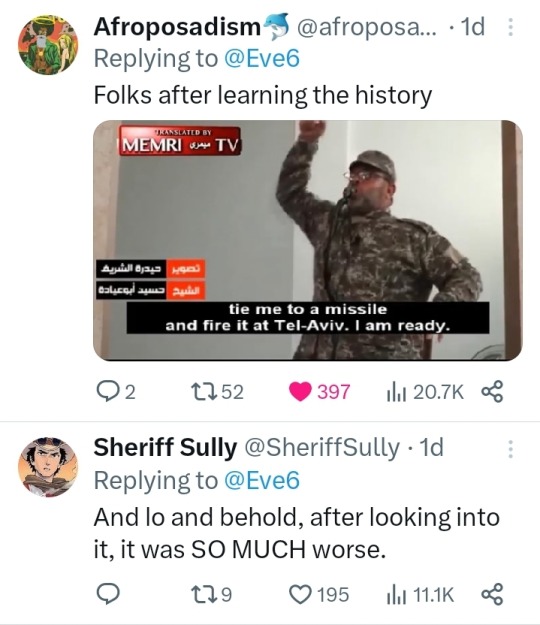


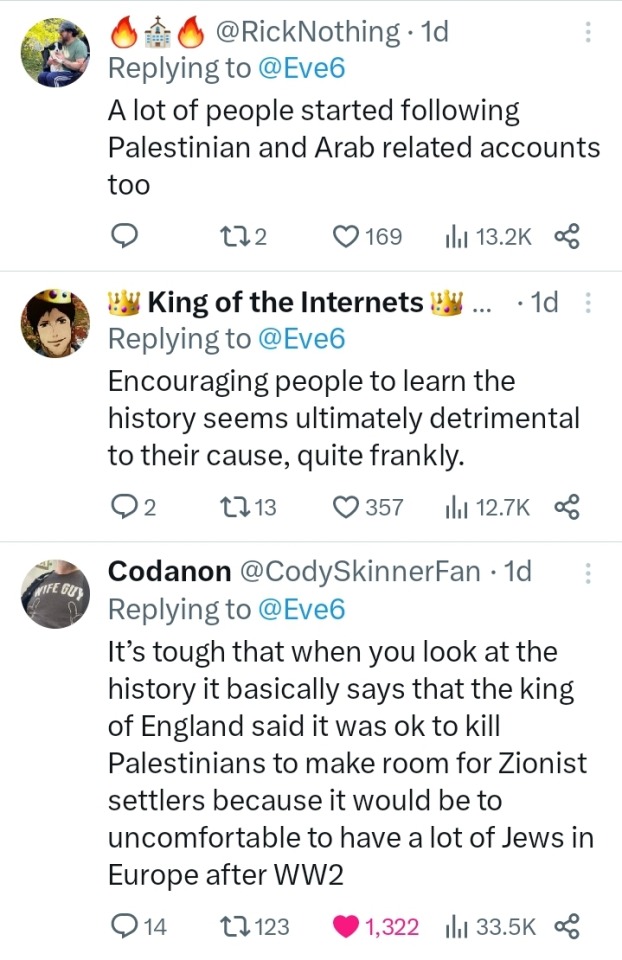
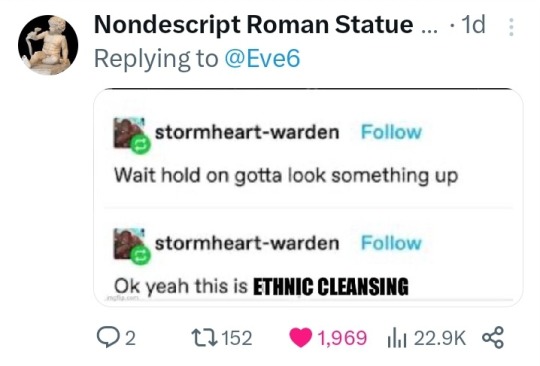
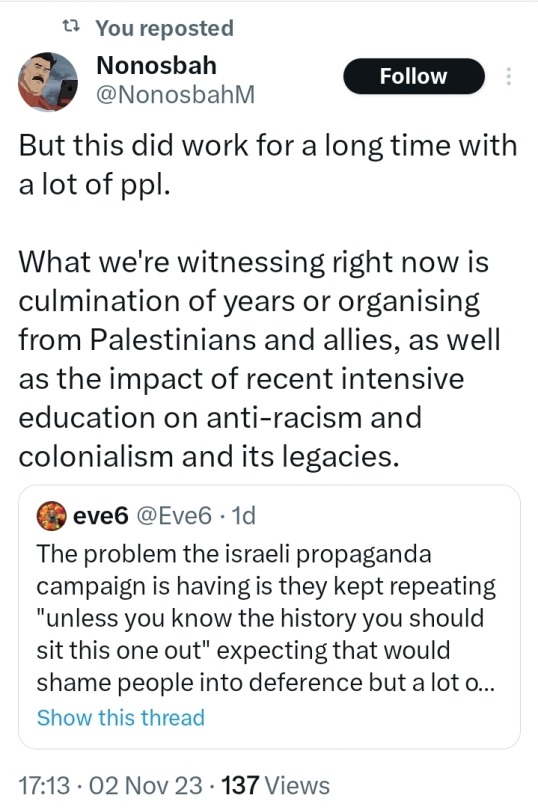
The Big Damn List Of Stuff They Said You Didn't Know
Thousands and thousands of years back in three minutes:
youtube
But closer to the issue...
Five free eBooks on the colonization and ethnic cleansing of Palestine
Pluto Books Free Palestine Reading List 30-50% off
LGBT Activist Scott Long's Google Drive of Palestine Freedom Struggle Resources
(includes some of the reading material recced below)
The Cambridge UCU and Pal Society Resources List
List of Academic and Literary Books Compiled by Dr. Kiran Grewal
Academic Books (many available in Goldsmiths library)
Rosemary Sayigh (2007) The Palestinians: From Peasants to Revolutionaries, Bloomsbury
Ilan Pappé (2002)(ed) The Israel/Palestine Question, Routledge
(2006) The Ethnic Cleansing of Palestine, OneWorld Publications
(2011) The Forgotten Palestinians: A History of the Palestinians in Israel, Yale University Press
(2015) The Idea of Israel: A History of Power and Knowledge, Verso Books
(2017) The Biggest Prison on earth: A history of the Occupied territories, OneWorld Publications
(2022) A History of Modern Palestine, Cambridge University Press
Rashid Khalidi (2020) The Hundred Years’ War on Palestine: A History of Settler Colonialism and Resistance, 1917-2017, MacMillan
Andrew Ross (2019) Stone Men: the Palestinians who Built Israel, Verso Books
Ariella Azoulay and Adi Ophir (2012) The One-State Condition: Occupation and Democracy in Israel/Palestine, Stanford University Press.
Ariella Azoulay (2011) From Palestine to Israel: A Photographic Record of Destruction and State Formation, 1947-1950, Pluto Press
Jeff Halper (2010) An Israeli in Palestine: Resisting Dispossession, Redeeming Israel, Pluto Press
(2015) War Against the People: Israel, the Palestinians and Global Pacification
(2021) Decolonizing Israel, Liberating Palestine: Zionism, Settler Colonialism, and the Case for One Democratic State, Pluto Press
Anthony Loewenstein (2023) The Palestine Laboratory: How Israel exports the Technology of Occupation around the World (CURRENTLY FREE TO DOWNLOAD ON VERSO)
Noura Erakat (2019) Justice for some: law and the question of Palestine, Stanford University Press
Neve Gordon (2008) Israel’s Occupation, University of California Press
Joseph Massad (2006) The persistence of the Palestinian question: essays on Zionism and the Palestinians, Routledge Edward Said (1979) The Question of Palestine, Random House
Memoirs, Novels & Poetry:
Voices from Gaza - Insaniyyat (The Society of Palestinian Anthropologists)
Letters From Gaza • Protean Magazine
Raja Shehadeh (2008) Palestinian Walks: forays into a Vanishing Landscape, Profile Books
Ghada Karmi (2009) In Search of Fatima: A Palestinian Story, Verso Books
Fatma Kassem (2011) Palestinian Women: Narratives, histories and gendered memory, Bloombsbury
Mourid Barghouti (2005) I saw Ramallah, Bloomsbury
Izzeldin Abuelaish (2011) I Shall Not Hate: A Gaza Doctor’s Journey on the Road to Peace and Human Dignity, Bloomsbury
Cate Malek and Mateo Hoke (eds)(2015) Palestine Speaks: Narrative of Life under Occupation, Verso Books
The Works of Mahmoud Darwish
Human Rights Reports & Documents
Information on current International Court of Justice case on ‘Legal Consequences arising from the Policies and Practices of Israel in the Occupied Palestinian Territory, including East Jerusalem’
UN Commission of Inquiry Report 2022
UN Special Rapporteur Report on Apartheid 2022
Amnesty International Report on Apartheid 2022
Human Rights Watch Report on Apartheid 2021
Report of the United Nations Fact-Finding Mission on the Gaza Conflict’ 2009 (‘The Goldstone Report’)
Advisory Opinion on the Legal Consequences of the Construction of a Wall in the Occupied Palestinian Territory, International Court of Justice, 9 July 2004
Films
Lemon Tree (2008)
Where Should The Birds Fly (2013)
Naila and the Uprising (2017)
Waltz with Bashir (2008)
Omar (2013)
Paradise Now (2005)
5 Broken Cameras (2011)
The Gatekeepers (2012)
Foxtrot (2017)
Gaza Mon Amour (2020)
The Viewing Booth (2020)
Innocence (2022) - Innocence (2022) | IDFA Archive
The Village Under the Forest (2013)
Palestine Film Institute's films on Gaza
Abby Martin - Gaza Fights For Freedom (2019) | Full Documentary | Directed by Abby Martin
Dan Cohen - Gaza Fights Back | MintPress News Original Documentary
‘The Promise’, directed by Peter Kosminsky (2010) (4 part miniseries on the creation of Israel)
Sources:
https://www.972mag.com/
https://jewishcurrents.org/
Jadaliyya ‘Gaza in Context’ Series
Jadaliyya “War on Palestine” podcast - The War on Palestine Podcast: Episode 1
Border Chronicle, Interview with Israeli anthropologist Jeff Halper
NGOs
B’Tselem
Breaking the Silence
Al Haq
Palestinian Feminist Collective
Yesh Din
DAWN
Amnesty International
Human Rights Watch
Gisha
Forensic Architecture
Instagram Accounts
gazangirl
mohammedelkurd
khaledbeydoun
motaz_azaiza
wizard_bisan1
etafrum
sara_mardini963
Twitter(X) Accounts
@PalStudies - Institute for Palestine Studies
@medicalaidpal
@middleeastmatters
@KenRoth - former executive director of Human Rights Watch
@YairWallach - Reader in Israel Studies at SOAS
@ PhilipProudfoot - researcher on development, humanitarianism and Arab states
@btselem - Israeli human rights documentation centre
@MairavZ - Senior Israel-Palestine Analyst at Crisis Group
@rohantalbot - Director of Advocacy and Campaigns at MedicalAidPal
@sarahleah1 - Executive Director of DAWN (democracy and human rights in MENA)
@alhaq_org - Palestinian human rights organisation
@FranceskAlbs - UN Special Rapporteur on the Occupied Territories
@Yesh_Din - Israeli human rights organisation
@sfardm - Michael Sfard, Israeli Human Rights Lawyer
@EphstainItay - Israeli international humanitarian lawyer
@saribashi - Program director for Human Rights Watch (Israeli living in Palestine)
@Gisha_Access - Israeli NGO
@_ZachFoster - Historian
Share widely!
(if any links are broken let me know. Or pull up the current post to check whether it's fixed.)
From River To The Sea Palestine Will Be Free 🇵🇸🇵🇸🇵🇸
83K notes
·
View notes
Text

The Costs of Registering a Company in Myanmar: What to Expect
Myanmar’s evolving economy and increasing openness to foreign investment make it a promising destination for entrepreneurs. However, understanding the costs associated with company registration in Myanmar is essential for planning your business venture effectively. At YKG Global, we have been assisting businesses since 1981, ensuring a seamless and cost-efficient company formation process.
Key Costs Involved in Company Registration Government Fees The Directorate of Investment and Company Administration (DICA) oversees company registrations in Myanmar. Government fees typically include:
Company name reservation: Approximately $50 Registration fee for a private limited company: Around $500 to $1,000, depending on the company’s share capital. Notarization and Documentation All required documents, such as the Memorandum and Articles of Association, must be notarized. These costs can range from $100 to $300 based on the service provider.
Office Rental and Address Registration Companies in Myanmar must provide a local registered address. Office rental costs vary by location, starting at $200 per month for basic office spaces in urban areas.
Legal and Consulting Services Engaging professional consultants like YKG Global ensures compliance with Myanmar’s complex regulations. Consultant fees range from $1,000 to $3,000, depending on the services required.
Bank Account and Share Capital A minimum share capital deposit is required to open a corporate bank account. This varies based on your business type but generally starts from $1,000.
Tax and Post-Registration Costs Registering for a Taxpayer Identification Number (TIN) and ongoing compliance costs should also be considered. Annual reporting fees may apply.
Why Choose YKG Global? With over four decades of expertise, YKG Global simplifies the process of company registration in Myanmar, saving you time and ensuring transparency. Our team provides tailored solutions to minimize costs and streamline operations, so you can focus on growing your business.
Conclusion Registering a company in Myanmar involves various costs, but careful planning and expert guidance can make the process efficient and cost-effective. Partner with YKG Global for end-to-end assistance and set your business up for success in Myanmar.
#business#consulting#company registration#taxation#success#investing#business registration#foreign company#finance#accounting#myanmar company registration list#myanmar
0 notes
Text
History, Formation, Healing Properties, Advantages, Applications, Maintenance Advice, and Style of Orange Kyanite
Following the discovery of the rich blue variation in Nepal in the 1990s, orange kyanite was found in Tanzania in the mid-2000s. Kyanite was mostly used in industry or as a mineral specimen prior to these findings. Normally blue, kyanite can occasionally be orange because of trace levels of manganese (Mn3+) in its structure.
Kyanite is a silicate mineral that often originates from sediments rich in aluminum that have been subjected to high pressure and temperatures ranging from mild to high. Numerous locations, including Nepal, Brazil, Zimbabwe, Switzerland, Kenya, Myanmar, and the United States, mine these alluring jewels.

0 notes
Text

Send from Sansgreet Android App. Sanskrit greetings app from team @livesanskrit .
It's the first Android app for sending @sanskrit greetings. Download app from https://livesanskrit.com/sansgreet
Nagaland formation day.
Nagaland is a state in north-eastern India. It is bordered by the state of Arunachal Pradesh to the north, Assam to the west, Manipur to the south and the Sagaing Region of Myanmar to the east. Nagaland's capital city is Kohima and its largest city is Dimapur. It has an area of 16,579 square kilometres (6,401 sq mi) with a population of 1,980,602 per the 2011 Census of India, making it one of the smallest states of India.
#sansgreet #sanskritgreetings #greetingsinsanskrit #sanskritquotes #sanskritthoughts #emergingsanskrit #sanskrittrends #trendsinsanskrit #livesanskrit #sanskritlanguage #sanskritlove #sanskritdailyquotes #sanskritdailythoughts #sanskrit #resanskrit #nagaland #nagalandtourism #december1 #celebratingsanskrit #northeastindia #kohima #dimapur #hornbillfestival #hornbill #naga #nagas #tribal #nagahills #nagatribe #indianstates
#greetingsinsanskrit#sanskritgreetings#sanskrittrends#trendsinsanskrit#livesanskrit#sanskrit#celebratingsanskrit#incredibleindia#indianarmy
0 notes